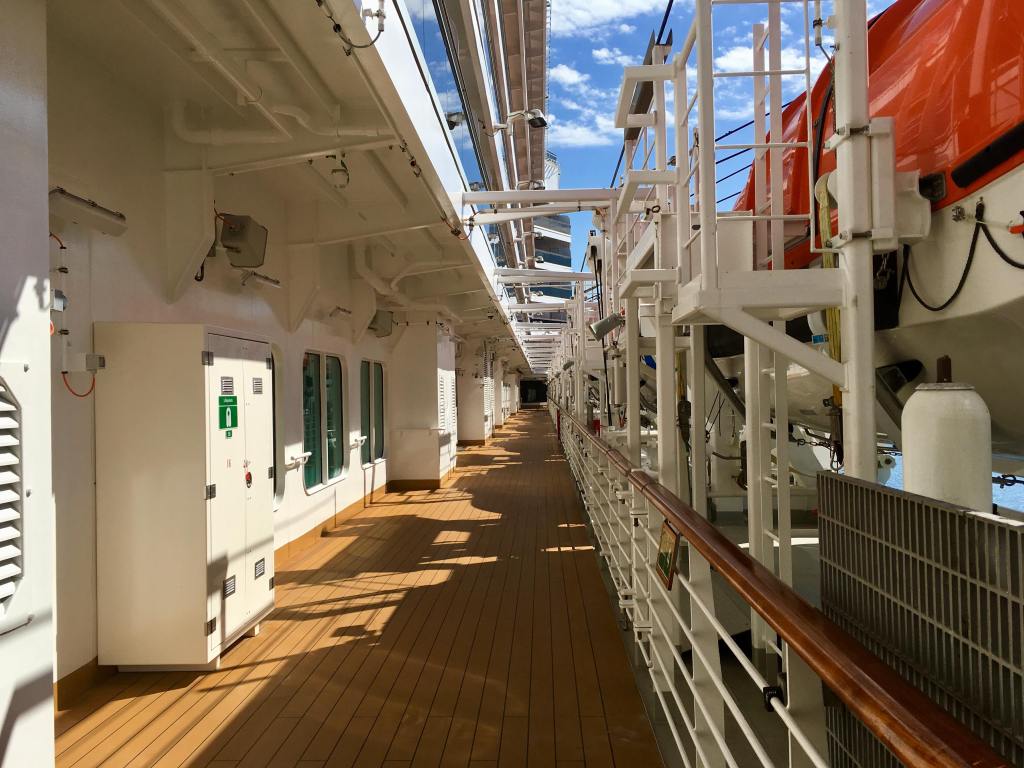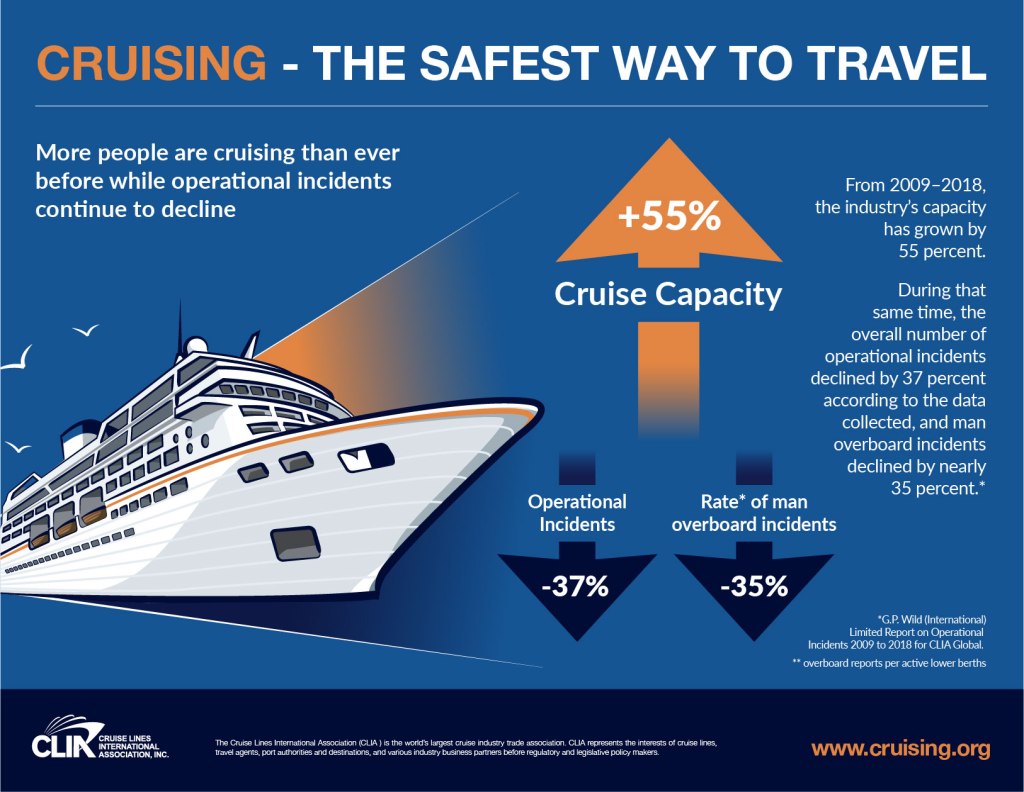Is cruising safe, at least from a technology standpoint? It’s a common question I hear from both cruise veterans and first-timer cruisers, especially after tragic accidents are splashed across news headlines worldwide. If you didn’t know, cruises are statistically one of the safest forms of travel. The chances of being endangered on a cruise ship are quite low, probably lower than the risk of driving in your car to the cruise port. I had an idea to write this post while I was onboard Costa Smeralda a couple of weeks ago and I have to say, I was quite surprised to find out how safe we are on the high seas… at least statistically!

Statistics
In 2020, the cruise industry will carry an estimated 32 million passengers, and they are in very good hands statistically, even safer than on commercial flights, which are widely known as a secure form of travel.
Fires. Power outages. Rogue waves. Rough seas. Hurricanes. Passengers “falling” overboard. You’ve heard about it all on the news, but before you work yourself into a panic, know this: Statistically, cruises are one of the safest forms of travel, the odds of dying on a cruise ship are roughly 1 in 6.25 million.
According to research compiled by the Daspit Law Firm, cruise ships have the lowest rate of deaths per billion passenger miles with 0.08. Compare that to 11.9 for rail travel, 3.3 for cars and trucks and 0.8 for commercial air, and traveling on the seas is a relatively safe option.
They’re getting safer!
A study by GP Wild analyzing cruise ship operational incidents shows that while worldwide cruise ship capacity grew by more than 55 percent from 2009 to 2018, over that same period the number of operational incidents has trended down 37 percent, making cruise lines’ safety record ahead of other modes of leisure transportation.

According to CLIA (Cruise Lines International Association), a typical cruise ship has more than 60 safety, environmental and health inspections each year. Safety regulations are rigorous – and ships often go substantially above and beyond what is required. In recent years, safety-related technology processes have become more sophisticated. Cruise ship safety continues to improve as technology advances, and the industry learns from developing and evaluating best practices.
As the industry has grown, regulators have updated and enhanced the safety requirements, including improvements in navigation equipment, shipboard safety management systems, life-saving equipment and training/certification standards.
Modern cruise ships are required to have state-of-the-art electronic navigational instruments, and most ships substantially exceed these regulatory requirements.
Ships are also required to have lifeboats, life rafts and life preservers for every person on board as well as additional capacity. The lifeboats are capable of being loaded, launched and maneuvered away from a ship within 30 minutes of a Captain’s order. Safety drills in multiple languages are held prior to departure from port.

The average cruise ship (for example Queen Elizabeth – above) carrying 2700 passengers and 800 crew has:
- 5 firefighting teams
- 4,000 smoke detectors
- 500 fire extinguishers
- 16 miles of sprinkler piping
- 5,000 sprinkler heads
- 6 miles of fire hose.
All cruise ships must be designed and operated in compliance with strict requirements of international law and must follow established rules and regulations to protect everyone on board.
All cruise ships are inspected on a quarterly basis to make sure machinery and emergency procedures are up to standards. Additionally, each ship sails with its own dedicated team of mechanics and engineers, who are specially trained to deal with any malfunctions that might arise. Crew members undergo rigorous training via safety drills to prepare them for emergency situations. All mainstream ships have onboard teams of doctors and/or nurses to deal with medical issues, and the control rooms on all vessels employ equipment dedicated to avoiding hurricanes and minimizing exposure to excessively rough waters.

Lifeboats
Lifeboat is one of the most important life-saving equipment onboard a ship, which is used at the time of extreme emergencies for abandoning a ship. Lifeboat is a smaller rigid vessel, secured onboard into davits so that it can be launched over the side of the ship with least time and mechanical assistance possible for an early escape of the crew from the ship.
As the size and capacity of modern cruise ship has increased there becomes a potential problem of having sufficient space to fit the required number of lifeboats. The cruise ship Oasis of the Seas (and her sister ships) is fitted with 18 mega lifeboats that are able to accommodate 370 people and weigh 17 tons when empty. A total of over 44 of the traditional 150 persons lifeboats would have to be fitted to accommodate the same number of passengers. The Oasis of the Seas has an overall length of 360m. The typical length of a 150 person lifeboat would be approximately 9.6m. So if fitted at a single level they would take up a length of over 210m (noise-to-tail) on each side of the vessel. These lifeboats were revolutionary but they are no longer the biggest at sea. Currently, cruise ships AIDAnova and Costa Smeralda (XL/Helios class ships) are fitted with the biggest lifeboats ever built for a cruise ship. They can accomodate 440 people, so these two cruise ships need only 16 of these rescue vessels.

Biggest lifeboats ever built!
The lifeboats are stowed and launched from a specially designed davit systems, which allows them to be lowered directly into the water from their stowed position rather than having to first swing out the davit and lifeboat before launch. The winches have a retraction system to lift the lowing block free from the lifeboat canopy and a retardation function to reduce the forces on the davit, winch system and lifeboat hook when stopped.
A lifeboat must carry all the types of equipment described under SOLAS and LSA codes, which are passed for the survival at sea. This includes rations, freshwater, first aid, compass, distress signalling equipment like rocket etc.

What can you do to stay safe?
Attend the muster drill! Before your vacation gets started, you must attend the muster drill. This is where you learn where your muster station is, how to put on a life jacket and what the alarms mean, should they be sounded. While most passengers listen attentively, every muster has a few people talking all the way through it, people on their phones and people trying to get a drink from the bar (all outlets are closed during muster). Even if you’ve heard the drill a thousand times, pay attention; don’t see it as an inconvenience, but rather as an important part of your cruise experience.
Familiarize yourself with the ship! When you get onboard for the first time, check out that evacuation map on the back of your cabin door. Physically follow the route to your lifeboat station, so you’re familiar with where you’re going if you have to do it for real.
Listen to the crew! In heavy seas, passengers are often advised to stay in their cabins, which makes seasickness worse. The captain is sometimes forced to skip a port of call if docking or tendering is too dangerous due to bad weather conditions. The very wide beam of the large ships makes them stable in most sea conditions, and if you have seasickness pills or a patch, the motion shouldn’t bother you. For safety, avoid outside decks in rolling seas or rain. The crew will close the decks if conditions are the least bit treacherous. So, your ship will weather the storm, and so will you.
Cruise liners can take incredible punishment from the ocean and stay upright. But if you’re aboard a liner during a severe storm it’s sensible to take shelter.
Don’t panick! One of the biggest problems with abandoning a ship is that many of the passengers are elderly. A younger fitter person may be confident they can get themselves into a lifeboat, but the elderly often aren’t. This causes a lot of apprehension and even panic. Do your best to assure those people, and help them when you can. Less panic means a better chance everyone will survive, so it’s in your best interests to keep them calm.

Have you ever felt unsafe on a cruise ship? I personally never felt unsafe and I’ve been in some pretty rough seas. Ship accidents are incredibly rare so you shouldn’t even think about that on your vacation, but do pay attention during the muster drill since it can save lifes even though it may seem like an inconvenience at the moment.
I hope that you feel a little bit safer now after reading how slim the chances are of being in a ship accident. It’s also reassuring to see how many procedures are in place that keep us safe on the high seas.
Many thanks to Mario, security officer onboard Costa Smeralda, for sharing a couple of fun & interesting ship facts with me!
If you’d like to read more, check out my post that’s all about “Old vs. New cruise ships” or a review of my most recent cruise on Costa’s new flagship, Costa Smeralda!
As always, thanks for reading, Dominik!
Great post 🙂
LikeLike
Thank you very much!
LikeLike
No problem 🙂 check out my blog when you get the chance 😁
LikeLike
Great post. I hope the cruise industry comes out strong again. I like cruising as it is easier than constantly changing accommodations.
LikeLike
I love your blog.. very nice colors & theme. Did you create this website yourself or did you hire someone to do it for you? Plz reply as I’m looking to create my own blog and would like to find out where u got this from. many thanks
LikeLiked by 1 person